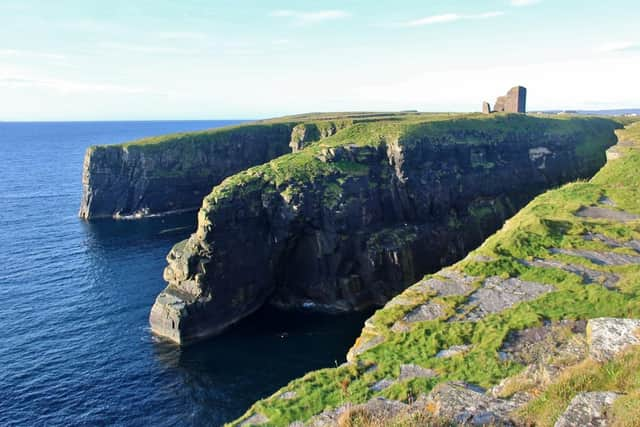One of Scotland 'oldest castles' could be 200 years younger than first thought
Castle of Old Wick in Caithness is dated by some to the 12th Century, but new thinking puts the construction of the now crumbling fortress to around 200 years later.
A single piece of timber retrieved from its walls may now hold the key to establishing an accurate date for the castle.
Advertisement
Hide AdAdvertisement
Hide AdRachel Pickering of Historic Environment Scotland, in a blog for Castle Studies Trust, described the castle as one of Caithness’ most “striking medieval sites” given its rugged location but added “time had not been kind” to the former stronghold.


Ms Pickering added: “There are many unanswered questions about this castle, not least ‘when was it built?’.
"Very little is known about the castle’s origin and development – there is limited documentary evidence relating to its earlier history and no diagnostic architectural features survive, making it very difficult to date.
"It was once thought to have been one of the earliest stone castles in Scotland, associated with Norse earls of Orkney and Caithness. However, more recently, scholars have questioned this, suggesting a 14th century date is much more likely for its construction.”
She said the only surviving fragment of timber left in the castle structure gave a “tantalising clue” to its construction history.
It was found within a joist socket of an upper floor, with the wood increasingly at risk of decay given its exposure to the elements.
The timber is believed to be oak, making it suitable for tree ring analysis, though it is in a very fragile state, Ms Pickering said.
Dendrochronologist Dr Coralie Mills removed the timber from the castle wall with the piece to be sent to Edinburgh for tree ring analysis.
Advertisement
Hide AdAdvertisement
Hide AdMs Pickering added: “From this we may be able to get a scientific date to indicate when the castle was built.
"At the very least, such a date may provide an age and provenance for the timber joist which provides an insight into phases of the castle’s development."
“We hope this research will shed light on the construction and development of Castle of Old Wick, by providing valuable scientific dating evidence. The project will also potentially support the on-going development of dendrochronological analysis within Scotland, as every new analysis can help to add to and refine existing tree-ring chronologies, which in turn supports future research.”
The piece of timber is made up of 60 rings, with its ability to give an accurate date thought to be marginal.
However, several carbon dating tests could be run to help build a true timeline for the castle.
Information at the castle site states it was “probably built by the Earl of Caithness, Harald Maddadson, in the 1160s".
Over time, it has been associated with families prominent in late medieval Caithness, including the Sutherlands and Oliphants, and was besieged during a feud between the the Sutherlands and Sinclairs in the 16th century.
Known to some as ‘The Old Man of Wick’, the castle is dominated by its four-storey tower. Parts of its seaward side have long since collapsed but a deep rock-cut ditch, which was once spanned by a drawbridge, can still be seen.
A message from the Editor:Thank you for reading this article. We're more reliant on your support than ever as the shift in consumer habits brought about by Coronavirus impacts our advertisers.
If you haven't already, please consider supporting our trusted, fact-checked journalism by taking out a digital subscription.
Comments
Want to join the conversation? Please or to comment on this article.
